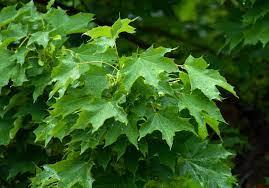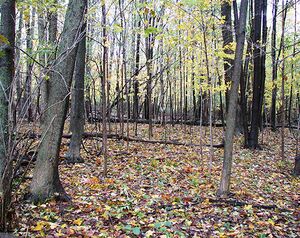Norway maple: Difference between revisions
| (11 intermediate revisions by one other user not shown) | |||
| Line 12: | Line 12: | ||
The Norway Maple is a species of maple tree native to central and Eastern Europe and Western Asia. It was later introduced to North America in the 1700s as a shade tree [1]. The tree grows from 60-100ft tall with a trunk up to 5ft in diameter. The bark is typically brownish grey with shallow grooves. Unlike many other species of maple trees, Norway Maples do not develop a shaggy bark as they mature. The leaves are deep green in summer months with 5 lobes, the lobes each have 3 side teeth [1]. In autumn the leaves turn a vibrant yellow color. The seeds of a Norway Maple are flat with two wings on opposite sides. The tree typically produces a large number of these seeds during breeding season and they are spread far and wide quite easily in the wind [2]. In its native habitat, the Norway Maple can live anywhere from 150-250 years, however in the United States the tree rarely reaches 100 years. This is because the tree is commonly planted along streets, leaving little room for the trees shallow root system to spread. The shallow roots of the tree also make it incredibly invasive as it can out-compete native Eastern United States tree species by up-taking nutrients much faster [3]. | The Norway Maple is a species of maple tree native to central and Eastern Europe and Western Asia. It was later introduced to North America in the 1700s as a shade tree [1]. The tree grows from 60-100ft tall with a trunk up to 5ft in diameter. The bark is typically brownish grey with shallow grooves. Unlike many other species of maple trees, Norway Maples do not develop a shaggy bark as they mature. The leaves are deep green in summer months with 5 lobes, the lobes each have 3 side teeth [1]. In autumn the leaves turn a vibrant yellow color. The seeds of a Norway Maple are flat with two wings on opposite sides. The tree typically produces a large number of these seeds during breeding season and they are spread far and wide quite easily in the wind [2]. In its native habitat, the Norway Maple can live anywhere from 150-250 years, however in the United States the tree rarely reaches 100 years. This is because the tree is commonly planted along streets, leaving little room for the trees shallow root system to spread. The shallow roots of the tree also make it incredibly invasive as it can out-compete native Eastern United States tree species by up-taking nutrients much faster [3]. | ||
[[File:Norway.jpeg|300px|thumb|left|Leaves of Norway Maple]] | |||
==Identification== | ==Identification== | ||
The Norway Maple distinguishes itself in a number of ways. It is distinguished easily from similar maple species by its larger, pointed leaves and lobes, as well as the presence of 1 or more teeth on all of its lobes. The Norway Maple is also consistently mistaken for a Sugar Maple. However the Sugar Maple has clear sap where as the Norway Maple has milky white sap. The Sugar Maples bark also is much shaggier than Norway Maples [6]. | The Norway Maple distinguishes itself in a number of ways. It is distinguished easily from similar maple species by its larger, pointed leaves and lobes, as well as the presence of 1 or more teeth on all of its lobes. The Norway Maple is also consistently mistaken for a Sugar Maple. However the Sugar Maple has clear sap where as the Norway Maple has milky white sap. The Sugar Maples bark also is much shaggier than Norway Maples [6]. | ||
== | [[File:Maplefruit.jpeg|200px|thumb|right|Fruit/seeds of Norway Maple]] | ||
==Environmental Status== | |||
The plant is not native to the northeastern United States. Factors contributing to its invasiveness here are its shallow root system, outcompeting native species for nutrients and moisture. The trees dense canopy may also cause a lack of light underneath them, resulting in less plant growth [4]. Herbivory is also less for Norway Maple saplings, allowing them to reach maturity much more consistently than other species. Perhaps its most competitive advantage is that it uses a photoperiod to determine when to sprout and drop leaves. Native American species typically use a temperature related timescale. Because of the Norway Maples photoperiod, it is able to sprout leaves and reproduce earlier than native species [5]. Because of these characteristics, the Norway Maple is able to outcompete native species and spread uncontrollably in the Eastern United States. Dense monoculture stands of Norway Maples have become increasingly common. | The plant is not native to the northeastern United States. Factors contributing to its invasiveness here are its shallow root system, outcompeting native species for nutrients and moisture. The trees dense canopy may also cause a lack of light underneath them, resulting in less plant growth [4]. Herbivory is also less for Norway Maple saplings, allowing them to reach maturity much more consistently than other species. Perhaps its most competitive advantage is that it uses a photoperiod to determine when to sprout and drop leaves. Native American species typically use a temperature related timescale. Because of the Norway Maples photoperiod, it is able to sprout leaves and reproduce earlier than native species [5]. Because of these characteristics, the Norway Maple is able to outcompete native species and spread uncontrollably in the Eastern United States. Dense monoculture stands of Norway Maples have become increasingly common. | ||
[[File:Invasion.jpeg|300px|thumb|right|Monoculture Norway Maple stand]] | |||
==Sources== | ==Sources== | ||
Latest revision as of 09:44, 12 May 2022
Description
| Norway Maple | |
|---|---|
| Kingdom: | Plantae |
| Phylum: | Tracheophyta |
| Class: | Magnoliopsida |
| Order: | Sapindales |
| Family: | Sapindacaea |
| Genus: | Acer L. |
| Species: | Acer Platanoides L. |
The Norway Maple is a species of maple tree native to central and Eastern Europe and Western Asia. It was later introduced to North America in the 1700s as a shade tree [1]. The tree grows from 60-100ft tall with a trunk up to 5ft in diameter. The bark is typically brownish grey with shallow grooves. Unlike many other species of maple trees, Norway Maples do not develop a shaggy bark as they mature. The leaves are deep green in summer months with 5 lobes, the lobes each have 3 side teeth [1]. In autumn the leaves turn a vibrant yellow color. The seeds of a Norway Maple are flat with two wings on opposite sides. The tree typically produces a large number of these seeds during breeding season and they are spread far and wide quite easily in the wind [2]. In its native habitat, the Norway Maple can live anywhere from 150-250 years, however in the United States the tree rarely reaches 100 years. This is because the tree is commonly planted along streets, leaving little room for the trees shallow root system to spread. The shallow roots of the tree also make it incredibly invasive as it can out-compete native Eastern United States tree species by up-taking nutrients much faster [3].

Identification
The Norway Maple distinguishes itself in a number of ways. It is distinguished easily from similar maple species by its larger, pointed leaves and lobes, as well as the presence of 1 or more teeth on all of its lobes. The Norway Maple is also consistently mistaken for a Sugar Maple. However the Sugar Maple has clear sap where as the Norway Maple has milky white sap. The Sugar Maples bark also is much shaggier than Norway Maples [6].

Environmental Status
The plant is not native to the northeastern United States. Factors contributing to its invasiveness here are its shallow root system, outcompeting native species for nutrients and moisture. The trees dense canopy may also cause a lack of light underneath them, resulting in less plant growth [4]. Herbivory is also less for Norway Maple saplings, allowing them to reach maturity much more consistently than other species. Perhaps its most competitive advantage is that it uses a photoperiod to determine when to sprout and drop leaves. Native American species typically use a temperature related timescale. Because of the Norway Maples photoperiod, it is able to sprout leaves and reproduce earlier than native species [5]. Because of these characteristics, the Norway Maple is able to outcompete native species and spread uncontrollably in the Eastern United States. Dense monoculture stands of Norway Maples have become increasingly common.

Sources
[1] Crowley, D.; Barstow, M. (2017). "Acer platanoides". IUCN Red List of Threatened Species. 2017: e.T193853A2286184. doi:10.2305/IUCN.UK.2017-3.RLTS.T193853A2286184.en
[2] BSBI List 2007 (xls). Botanical Society of Britain and Ireland.
[3] Love, R (2003). "Introduced Species Summary Project: Norway maple (Acer platanoides)". Columbia University.
[4] Shannon L. Galbraith-Kent; Steven N. Handel (2008). "Invasive Acer platanoides inhibits native sapling growth in forest understorey communities"
[5] Mitchell, AF (1974). A Field Guide to the Trees of Britain and Northern Europe. Collins. ISBN 978-0-00-212035-7.
[6] Rushforth, K (1999). Trees of Britain and Europe. Collins. ISBN 978-0-00-220013-4.